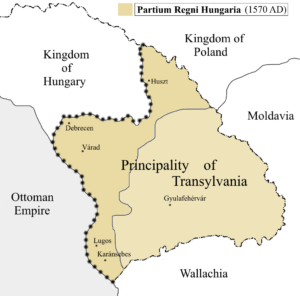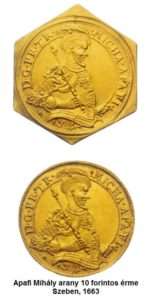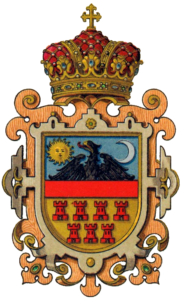Prince Apafi Mihály (1632-1690)

He came from an old Transylvanian family, the Apafi family, his father György was an advisor to Prince Rákóczi György I, and his mother Petki Borbála was also a member of an old Transylvanian family. Their son Mihály was born on the family’s ancestral estate in Ebesfalva on 3 November 1632.

He went to school here and later studied in Gyulafehérvár, Lőcse and Bártfa. On his return he served Prince Rákóczi György II, taking part in the prince’s campaigns in Moldavia, Wallachia, and even in the tragic Polish War.
Apafi, the prince of Transylvania
Apafi came to the throne at a time when the Transylvanian state was fatally weakened: after Rákóczi György II (r. 1648-1660) had launched a campaign to seize the Polish throne in 1657 in defiance of the Turkish ban, the disobedient prince was punished by the Porte by forcing the Crimean Tatars into Transylvania. You can read more about this war here:

In the years after 1657, all the works of the Golden Age of Transylvania were reduced to ashes, and as a guarantee, the castle of Várad and the region of Partium came under direct Turkish rule from 1660. Kemény János, who had lost his life in the battle of Sászfenes (22 May 1660), succeeded Rákóczi in the principality after defeating Barcsay Ákos, who had initially been supported by the Turks. (Please note that I use the oriental name order for Hungarians, where the surname comes first). Here is more about these princes:
https://www.hungarianottomanwars.com/essays/prince-kemeny-janos-of-transylvania-1607-1662/
Finally, the Porte chose Apafi, who had been captured by the Crimean Tatars after the Polish campaign of 1657 and released for a substantial ransom after four years. He returned from captivity on 8 November 1660 and retired to his estates. He was taken from the side of his wife, who was about to give birth, by the soldiers of Ali Pasha of Buda for his inauguration on 2 September 1661. On 10 September 1661, Serdar Ali Pasha ordered him to take the throne. But he had no desire to rule and was a quiet, reserved man. His passions, studying the mechanism of clocks or reading, (would have) demanded silence and tranquillity.

However, his wife, Bornemisza Anna, who had married him in 1653, assisted him in the administration of the estate and kept a detailed diary. Her cookery book, a mirror translation of Max Rumpoldt’s work, is evidence of what the ruling families of the time ate.
The new prince was understandably unpopular in Transylvania, and the nobles of the country continued to support Kemény János, the other Prince of Transylvania who relied on the Habsburgs’ help. Apafi’s rule was finally secured by the Turkish victory at Nagyszőlő in January 1662, during which Kemény János was killed. The new ruler, who was the only one in power, came to power under difficult circumstances, and the ominous lesson he had to learn during his reign, following the example of Rákóczi György, was that one wrong decision could lead to the destruction of Transylvania and with it the hopes of a future independent Hungarian state. To better understand the position of Transylvania, here is an article about its semi-independence, based on the lecture by Balla Péter:
https://www.hungarianottomanwars.com/essays/transylvanian-principality-a-vassal-state-of-the-turks/

The country was in ruins from years of Turkish-Crimean Tatar devastation, and the Porte raised the annual tax to 40,000 gold pieces and imposed an extra tribute on the principality. Apafi banned the export of precious metals and severely punished counterfeiting. He gained additional income from princely monopolies (salt, mercury, precious metals). He levied new taxes, taxed the lesser nobles and, when necessary, even demanded money from the nobility. This quickly brought in considerable revenue, which paid off the tax debt.

As far as possible, Apafi’s reign was a period of prosperity: he restored the manufactories, founded educational institutions, including Romanian schools, promoted religious tolerance, and welcomed with great hospitality scholars and politicians who had fled the Habsburg-ruled Kingdom of Hungary (e. g. However, he had little room for maneuver in foreign policy, for after 1660 the Porte put more pressure on Transylvania than ever before, increasing taxes and war reparations and interfering in everyday affairs, so it was not easy for Apafi to continue the legacy of his predecessors.

The prince aimed to preserve the partial independence of Transylvania and to establish an independent Hungary after the expulsion of the Turks, and his main task was to gather forces. Apafi was very interested in the Kingdom of Hungary, he also contacted the Viennese court and at the same time, he supported and later welcomed the lords involved in the Wesselényi conspiracy. Meanwhile, as a vassal of the Sultan, he was forced to take part in the Treaty of Vasvár in 1663-64, which established the unfavorable position of Transylvania after 1660.

He sought contact with the Hungarian estates in the Kingdom of Hungary (especially during the Wesselényi movement) and regulated the Principality’s relations with the Porte. The establishment of relations with King Louis XIV of France was a new line of foreign policy. He tried to increase the military power of the country. Apafi sought the alliance of the French against the Habsburgs to preserve independence, and a great achievement of his diplomacy was the mention of Transylvania as an ally of Louis XIV (r. 1643-1715) in the Treaty of Nijmegen of 1679.

After the suppression of the Wesselényi movement, he took in many persecuted and doomed soldiers from the Borderlands. He tried to maintain a balance between the two empires, but the support he gave to the refugees drove him away from Vienna. After the appearance of Thököly Imre, the Porta also withdrew their support from him and supported Thököly.

For the cautious prince, Thököly Imre’s actions were a severe blow; the organization of the Kuruc movement had deprived the country of the refugees who, in Apafi’s eyes, formed the basis of a liberating army. With Thököly’s anti-Habsburg uprising, he essentially squandered this force, and with his “kingdom” in the Highlands, Thököly carved out a fourth part of Hungary.

In the second half of his reign, Chancellor Teleki Mihály gained great influence in his court, and on more than one occasion he pushed through his own interests almost against the will of the prince. When necessary, he would strike hard and condemn those who opposed him (Haller János, Kapi György, Lázár István, Dániel István).

After the failure of Kara Mustafa’s campaign in Vienna in 1683, the Holy League counter-attack began, and the liberation of the country began, initially leading to a permanent Turkish military presence in Transylvania. Apafi had already joined the Holy League in a secret treaty in early 1684, but the weakening Ottoman Empire and the Crimean Tatar auxiliaries were still too much for the principality to withstand.

The recapture of Buda and the Christian victory at Nagyharsány in 1687 cost the Porte so much that it was forced to abandon Transylvania, where the troops of Charles of Lotharingia marched later that year to demand winter quarters, which the exhausted Transylvania could only pay for with two million forints.

In Balázsfalva, Apafi signed a treaty with Archduke Charles, according to which the Habsburg Empire would recognize the independent statehood of Transylvania, and also guaranteed to prevent harassment and plundering by the military in several points. In 1688, General Caraffa forced Apafi to sign a new treaty at Fogaras Castle, in which he accepted the Emperor’s majesty and had to renounce his claim to an independent Hungarian state from the Habsburgs. Emperor Leopold recognized the princedom of Apafi and his son and the right of Transylvania to choose its prince.

Later, however, the Habsburgs abandoned the treaty and took the fate of Transylvania into their own hands. In 1687, the imperial armies invaded Transylvania. Although the commander-in-chief, Charles of Lotharingia, duly honored the agreement, albeit at no small financial cost to Transylvania, his successor, General Caraffa, treated the Principality as a completely conquered province. Apafi and his wife retreated to Fogaras Castle and waited in fear to see what would happen.

After the death of the monarch, Leopold I (r. 1657-1705) issued the Diploma Leopoldinum of 1690, which regulated the situation of Transylvania within the Habsburg Empire, granting the principality an independent governorship, a parliament, and greater religious tolerance (compared to the rest of the Empire).

He had 11 children by his wife, but only one, Mihály, born in 1676, reached adulthood. Bornemissza Anna died in 1688 and it was a devastating blow. He shut himself in and did not admit people. Two years later, during a hunting trip, he caught a cold and fell into bed. Apafi died in the castle of Fogaras on 15 April 1690, leaving his principality to his son, Apafi Mihály II, who had no real power, only his title. Although the Porte recognized him as a prince, he never ruled. He was taken to Vienna, where he died in 1713.

In the historical memory Apafi is remembered as a weak-minded ruler and an incompetent prince, a judgment often made in parallel with that of Bethlen Gábor (r. 1613-1629) or Rákóczi György I (r. 1630-1648). Cserei Mihály, who did not think much of him, wrote: “This is how the pious Apaffi Mihály, who would have been better suited to be a priest than a prince, perished…”.
Those who condemn Apafi, however, fail to take into account his virtues and the fact that his reign could not have been a golden age, not because of the prince’s fault, but because of the crumbling Transylvania and the changing political circumstances, and that his plans were thwarted by forces beyond his control.

Source: Tarján M. Tamás, Rubicon, and Szibler Gábor
Dear Readers, I can only make this content available through small donations or by selling my books or T-shirts.
If you like my writings, please feel free to support me with a coffee here:
You can check out my books on Amazon or Draft2Digital, they are available in hardcover, paperback, or ebook:
https://www.amazon.com/dp/198020490X
or at https://books2read.com/b/boYd81


My work can also be followed and supported on Patreon: Become a Patron!http://Become a Patron!


https://hungarianottomanwars.myspreadshop.com/all



